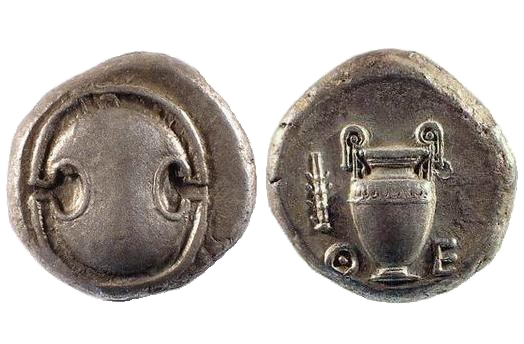
about ancient nomos
Ancient Nomos Art is a museum of galleries exhibiting ancient coins and ancient mint maps. The coin gallery displays the diverse art and history of hand-crafted ancient Greek, Roman, Byzantine, Persian and Medieval coinage. The ancient mints mapping gallery features Greek, Roman, Byzantine, Asia Minor and Medieval mint city regions and territories. Visitor's are welcome to explore, study and enjoy Ancient Nomos Art.

Greek, Boeotia – 425 BC
Thebes
From Ancient Galleries

Obverse: Oval Boeotian shield with two semicircular openings on either side.
Reverse: Two-handled fluted Amphorae with downward club in field to the left.
LEGEND SYMBOLS
Obv. Upright and facing Boeotian shield of Thebes. Rev. Standing Amphora with two handles; Θ-Ε across lower field with downward club in field to left; all within circular incuse.
Ancient Boeotia was a diverse region of central Greece that shared a mountainous southern border with Megaris, Attica and Gulf of Corinth and a rough northern hill country boundary with Phokis and Lokris. The centrally located city of Thebes was the largest in Boeotia and minting place for this coin. Thebes was thought to have been discovered by Kadmos, disseminator of the Greek alphabet and brother of Europa. During the late 6th century BC, Thebes established the first Boeotian League confederacy, forming a unity alliance with all of its neighboring cities. Boeotian coinage commenced shortly after the League’s unity. As a result, the new Boeotia city-state, united in an Amphictyonic confederation, created one of the earliest known Federal currencies of ancient Greece. The unique characteristics of Boeotian coinage served to distinguish the currency from other Greek city-states. The coins obverse design consists of the distinctive circular Boeotian shield with two semicircular openings at either side. It is thought that the shield is a symbol that signified a powerful protective image and strong defense identity for the newly unified League. Others have suggested the shield is also a religious emblem, one of Athena Itonia, who’s Temple of Coroneia was the place where the Boeotian’s gathered to celebrate League festivals (Paus, IX 34). Still others consider it the symbolic Shield of Ares, whose statue marked the starting point of the horse races during Boeotian League games (Foucart, 1885). The circular incuse reverse depicts an upright amphora with two handles imitating volutes, a round base and indented pattern with egg-molding on the lip and upper body. The amphora was an important object in commerce, ceremony, rituals, and as vessel used to deliver prized commodities such as olive oil and wines. A downward oriented Boeotian club is shown to the left with the Greek ethnic Θ – E, abbreviation letters for Thebes, flanking the fields on either side.
DOCUMENTATION
Value: Stater. Metal: AR Silver. Weight: 12.11 grams. Mint: Thebes, Boeotia. Date: circa 425-400 BC.
Attribution: Svoronos, Myron Hoard, plate gamma, 22; BMC p.78, 95-96; L. Hamburger 98, 1933, 595; BCD 2006, 400.
Legend, Documentation and Attribution
